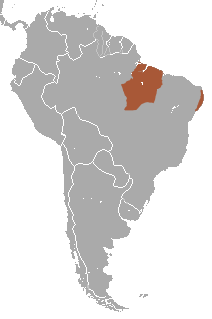Red-handed howler monkey
| Red-handed howler monkey | ||||||||||||
|---|---|---|---|---|---|---|---|---|---|---|---|---|

Red-handed howler monkey ( Alouatta belzebul ) |
||||||||||||
| Systematics | ||||||||||||
|
||||||||||||
| Scientific name | ||||||||||||
| Alouatta belzebul | ||||||||||||
| ( Linnaeus , 1766) |
The red-handed howler monkey ( Alouatta belzebul ) is a species of primate from the genus of the howler monkey within the spider- tailed monkey (Atelidae). He lives in northeastern Brazil .
features
Like all howler monkeys, they are relatively large, stockily built primates. The limbs are long and strong, the tail long and designed as a prehensile tail - it has a hairless point at the rear end of the lower side. With a weight of 6.5 to 8.0 kilograms, males are significantly heavier than females, who reach between 4.8 and 6.2 kilograms. The head-trunk length of the males is 58 to 65 cm, plus a 56 to 70 cm long tail. In females, the head-torso length is 37 to 50 cm and the tail is 45 to 57 cm long. The fur of the red-hand howler monkey is predominantly black, the reddish-brown color of the hands, feet and the tip of the tail, which gives it its name, does not occur in all animals. In some areas, all animals of one or both sexes can also be solid black or reddish. The scrotum of the males is rust-red.
distribution and habitat
Red-handed howler monkeys live in northeastern Brazil . They inhabit the areas south of the Amazon from the Rio Xingu and Rio Iriri to the state of Maranhão , the island of Marajó in the Amazon estuary and, isolated from the rest of the range, the northeastern coastal forests in the states of Rio Grande do Norte , Paraíba , Pernambuco and Alagoas . They are forest dwellers who occur in rain , but also other types of forest.
Way of life
These animals are diurnal tree dwellers. They live in groups made up of one (sometimes two) male, several females and their pups. In the morning in particular, the loud roaring typical of the genre can be heard, which is primarily intended to point out other groups of their own whereabouts. These animals are herbivores that feed on leaves, fruits, and flowers.
Systematics
The red-handed howler monkey was first scientifically described in 1766 by the Swedish naturalist Carl von Linné under the name Simia belzebul . The Amazonian black howler monkey ( A. nigerrima ) and the Spix howler monkey ( A. discolor ), whose distribution areas adjoin that of the red -hand howler monkey to the west, have long been considered subspecies of the red -hand howler monkey, but are now listed as separate species. The Maranhão howler monkey , which occurs in a wide gap in the distribution area of the red -handed howler monkey , was also long considered a subspecies of the red -handed howler monkey , but was raised to the species rank in 2006. This is again called into question in a study published in October 2015. A comparison of the cytochrome b genome of both forms demonstrated that the Maranhao-Brüllaffe deep within the belzebul Alouatta - clade stands.
Danger
The main threat to these animals is the destruction of their habitat, especially in the north-east Brazilian coastal forests. In addition, they are hunted for their meat. The IUCN lists the species as endangered ( vulnerable ).
literature
- Thomas Geissmann : Comparative Primatology. Springer-Verlag, Berlin et al. 2003, ISBN 3-540-43645-6 .
- Don E. Wilson, DeeAnn M. Reeder (Eds.): Mammal Species of the World. A taxonomic and geographic Reference. Johns Hopkins University Press, Baltimore MD 2005, ISBN 0-8018-8221-4 .
supporting documents
- ↑ a b c A. B. Rylands & RA Mittermeier: Family Atelidae (Howlers, Spider and Woolly Monkeys and Muriquis). Pages 525-534 in Russell A. Mittermeier , Anthony B. Rylands & Don E. Wilson : Handbook of the Mammals of the World - Volume 3: Primates. Lynx Editions, 2013 ISBN 978-8496553897
- ^ Renato Gregorin (2006). Taxonomia e variação geográfica das espécies do gênero Alouatta Lacépède (Primates, Atelidae) no Brasil . Rev. Bras. Zool. 23 (1). doi: 10.1590 / S0101-81752006000100005
- ↑ Maria Carolina Viana, Cibele Rodrigues Bonvicino, Juliana Gonçalves Ferreira, Lendro Jerusalinski, Alfredo Langguth & Héctor Seuánez: Understanding the Relationship Between Alouatta ululata and Alouatta belzebul (Primates: Atelidae) Based on Cytogenetics and Molecular Phylogenetics. Oecologia Australis 19 (1): 173-182 October 2015, DOI: 10.4257 / oeco.2015.1901.11
- ^ IUCN entry
